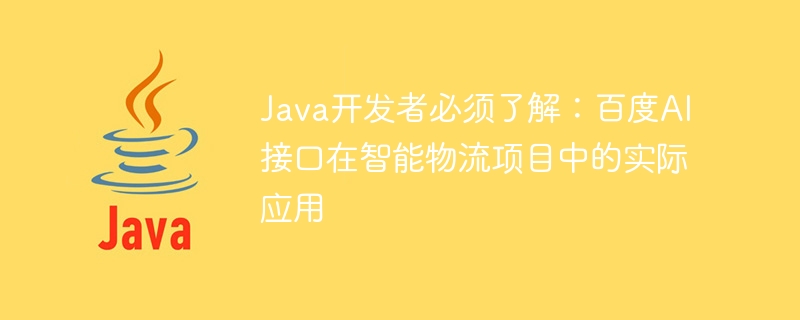

Java developers must understand: the practical application of Baidu AI interface in intelligent logistics projects
With the continuous development and application of artificial intelligence technology, more and more of companies are beginning to apply artificial intelligence technology to existing operations to improve efficiency and quality. As a field full of challenges, smart logistics has also begun to introduce artificial intelligence-related technologies. In the field of Java development, Baidu AI interface provides many powerful capabilities. This article will introduce the application of Baidu AI interface in Java development through the practical application of an intelligent logistics project.
1. Project Overview
The intelligent logistics project aims to use artificial intelligence technology to optimize and intelligently process all aspects of the logistics process to improve logistics efficiency and reduce costs. The project includes transportation route optimization, cargo identification, exception handling and other functions.
2. Introduction to Baidu AI interface
Baidu AI interface is a series of artificial intelligence API interfaces provided by Baidu, including natural language processing, image recognition, speech recognition and other functions. These interfaces encapsulate complex algorithms and models, allowing developers to directly call these interfaces to implement various artificial intelligence-related functions.
3. Sample code
Transportation path optimization is one of the important functions in smart logistics projects. By optimizing the route of cargo transportation, travel distance and time can be reduced, thereby improving logistics efficiency.
The following is a sample code for transportation route optimization using Baidu Map API:
import com.baidu.mapapi.map.BaiduMap;
import com.baidu.mapapi.map.MapOptions;
import com.baidu.mapapi.map.MapView;
public class TransportationOptimization {
public static void main(String[] args) {
// 初始化地图
MapOptions options = new MapOptions();
options.mapType(MapOptions.MapType.NORMAL);
options.zoomControlsEnabled(true);
BaiduMap baiduMap = new MapView(options).getMap();
// 获取货物起始和终点位置
String origin = "北京市";
String destination = "上海市";
// 调用百度地图API获取运输路径
String route = baiduMap.getRoute(origin, destination);
// 对运输路径进行优化处理
String optimizedRoute = optimizeRoute(route);
System.out.println("优化前运输路径:" + route);
System.out.println("优化后运输路径:" + optimizedRoute);
}
private static String optimizeRoute(String route) {
// TODO: 使用百度AI接口对运输路径进行优化处理
return route;
}
}Smart Logistics Project , fast and accurate identification of goods is very critical, which can reduce manual operation time and error rate.
The following is a sample code for cargo identification using Baidu image recognition API:
import com.baidu.aip.imageclassify.AipImageClassify;
import org.json.JSONObject;
public class GoodsRecognition {
public static void main(String[] args) {
// 创建一个AipImageClassify对象
AipImageClassify client = new AipImageClassify("App ID", "API Key", "Secret Key");
// 读取要识别的货物图片
String imagePath = "path/to/image.jpg";
byte[] image = readImage(imagePath);
// 调用百度图像识别API进行货物识别
JSONObject result = client.advancedGeneral(image, null);
// 解析识别结果
String goodsName = parseRecognitionResult(result);
System.out.println("货物名称:" + goodsName);
}
private static byte[] readImage(String imagePath) {
// TODO: 读取指定路径的图片文件,返回字节数组
return null;
}
private static String parseRecognitionResult(JSONObject result) {
// TODO: 解析百度图像识别API返回的识别结果,返回货物名称
return null;
}
}Smart logistics In projects, it is very important to handle abnormal situations in a timely manner. Using Baidu's natural language processing API, logistics abnormal information can be effectively analyzed and processed.
The following is a sample code for exception handling using Baidu Natural Language Processing API:
import com.baidu.aip.nlp.AipNlp;
import org.json.JSONObject;
public class ExceptionHandling {
public static void main(String[] args) {
// 创建一个AipNlp对象
AipNlp client = new AipNlp("App ID", "API Key", "Secret Key");
// 待处理的异常信息
String exceptionText = "货物运输过程中发生了交通事故";
// 调用百度自然语言处理API进行文本分类
JSONObject result = client.lexer(exceptionText);
// 解析分类结果
String exceptionType = parseClassificationResult(result);
// 根据异常类型进行相应处理
handleException(exceptionType);
}
private static String parseClassificationResult(JSONObject result) {
// TODO: 解析百度自然语言处理API返回的分类结果,返回异常类型
return null;
}
private static void handleException(String exceptionType) {
// TODO: 根据异常类型进行相应处理
System.out.println("处理结果:根据异常类型进行相应处理");
}
}4. Summary
The above is an example of using Baidu AI interface in a smart logistics project code. Through Baidu Map API to realize transportation route optimization, Baidu Image Recognition API to realize cargo identification, and Baidu Natural Language Processing API to realize exception handling, Java developers can quickly implement some core functions in smart logistics projects.
Of course, the application of Baidu AI interfaces is not limited to smart logistics projects. They have extensive applications in speech recognition, smart customer service, smart translation and other fields. Therefore, as a Java developer, mastering the use of Baidu AI interface will bring great convenience and efficiency improvement to your development work in the field of artificial intelligence.
The above is the detailed content of Java developers must understand: the practical application of Baidu AI interface in smart logistics projects. For more information, please follow other related articles on the PHP Chinese website!
 Why do the words after typing in word disappear?
Why do the words after typing in word disappear?
 How to use the month function
How to use the month function
 Usage of setInterval in JS
Usage of setInterval in JS
 Tutorial on making inscribed coins
Tutorial on making inscribed coins
 Cost-effectiveness analysis of learning python, java and c++
Cost-effectiveness analysis of learning python, java and c++
 Introduction to frequency converter maintenance methods
Introduction to frequency converter maintenance methods
 How to use fusioncharts.js
How to use fusioncharts.js
 How many types of usb interfaces are there?
How many types of usb interfaces are there?




